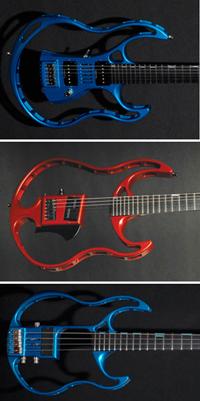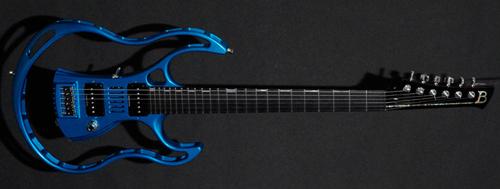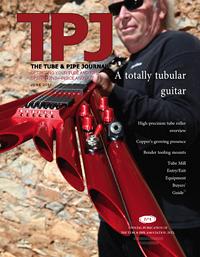- FMA
- The Fabricator
- FABTECH
- Canadian Metalworking
Categories
- Additive Manufacturing
- Aluminum Welding
- Arc Welding
- Assembly and Joining
- Automation and Robotics
- Bending and Forming
- Consumables
- Cutting and Weld Prep
- Electric Vehicles
- En Español
- Finishing
- Hydroforming
- Laser Cutting
- Laser Welding
- Machining
- Manufacturing Software
- Materials Handling
- Metals/Materials
- Oxyfuel Cutting
- Plasma Cutting
- Power Tools
- Punching and Other Holemaking
- Roll Forming
- Safety
- Sawing
- Shearing
- Shop Management
- Testing and Measuring
- Tube and Pipe Fabrication
- Tube and Pipe Production
- Waterjet Cutting
Industry Directory
Webcasts
Podcasts
FAB 40
Advertise
Subscribe
Account Login
Search
Getting in tune with tube
Guitar-maker, innovator likes the bright tone, resonance of 6061-T6 tube
- By Eric Lundin
- June 2, 2011
- Article
- Shop Management

One of Branch’s latest guitar designs, the AirTube V, is reminiscent of Gibson’s iconic Flying V. Full-time machinist and part-time guitar builder Gordon Branch noticed that aluminum tubing produced an interesting combination of resonance and sustain. “This inspired my guitar-making to take a whole new direction,” he said.
What happens when your high school has a well-funded industrial arts program, you grow up in a community with a thriving live-music scene, and you want to learn to play guitar but can’t afford a nice one? If you have extraordinary patience, some ingenuity, and take lessons from a master guitar builder, the sky is the limit.
Gordon Branch, who grew up near San Francisco, used his education to pursue a career as a machinist and later turned his interest in guitars into a hobby and later a full-time job. He went on to dream up the biggest innovation in guitar design since the electric pickup was added in the 1930s.
Like most innovators, Branch didn’t take a direct path from high-school shop class student to musical instrument designer. The first two steps down this path were signing up for guitar-playing lessons and purchasing an inexpensive guitar. Disappointed with the quality of the guitar, he would later take a guitar-making class, learn how it’s done, then forge his own path. He has been handcrafting unique guitars and basses ever since.
Aspirations by the Bay
“I was lucky growing up in the San Francisco Bay area in the 1970s,” Branch said. “San Leandro High School had an excellent industrial arts program. A guy could go down the street after graduation and get a good job at Caterpillar.” He credits Andy Koval, his shop teacher, for making a difference in his life and inspiring a career in metalworking.
Branch got a job as a maintenance machinist, working with metal and plastic, at Raytheon’s semiconductor division in Mountain View, Calif. He was the sole machinist in an operation that employed more than 1,000 people. This unique position allowed him to do some moonlighting, and it wasn’t long before Branch was staying late at Raytheon to work on some side projects.
Outside of work, Branch yearned to learn to play guitar. He signed up for guitar-playing lessons and parted with $50 for an inexpensive, imported acoustic guitar, but it fell far short of his expectations.
“I looked in the phone book and I found guitar-making lessons taught by Ervin Somogyi,” he said. The class was expensive, so Branch proposed a trade: Branch would design and manufacture some guitar-making tools instead of paying the class fee. Somogyi accepted. Although Branch didn’t realize it at the time, Somogyi wasn’t just any old guitar builder. He was a master builder.
“These days he charges $25,000 per instrument.”
Wood (Not Metal). In that class, Branch learned that guitars and their low-pitched cousins, basses, have one thing in common: They are made of wood. Wood is easy to cut, sand, and bend, giving the instrument-maker quite a bit of versatility in the instrument’s size and shape. People who build and repair stringed instruments, luthiers, work with many woods that are common, such as maple, cherry, and rosewood, and some that are exotic, such as koa, bubinga, and snakewood.
The anatomy of an acoustic guitar is straightforward. The two main components are the neck and the body. The size and shape of the body (resonant cavity) and the material used for the top (soundboard) interact to give a guitar its signature sound. Various species of wood are used for the neck and the fretboard for their natural feel and how they interact with the strings. In short, wood provides endless variations in the way a guitar or bass sounds.

Branch’s Airframe resembles a conventional guitar design, but his use of aluminum billet allowed him to give it a unique and modern look.: Branch uses a manual Bridgeport mill to do the final machining on his guitars and basses, bringing an aluminum billet that originally was 60 lbs. down to 5 lbs. Aluminum’s low density makes it ideally suited for these instruments. A denser metal would make the instrument too heavy for most players.
In Somogyi’s class, Branch built an acoustic guitar. Since then he has built nothing but electrics.
“I was drawn to build electrics because of the sound and the freedom of design possibilities,” he said.
Branch eventually made every guitar and bass configuration imaginable: right-handed and left-handed, single cutaway and double cutaway, single pickup and multiple pickup.
Then he started getting really creative.
Metal (Not Wood). A career machinist familiar with metals, Branch realized that metal might be suitable for a guitar or bass body. Many metals have good acoustic characteristics, but the weight and cost of metals are two limiting factors; guitar and bass bodies have to be lightweight and affordable. Branch found that aluminum would work.
“Aluminum has a great natural resonance,” he said. He homed in on an aircraft-grade aluminum, alloy 6061-T6, and started working up a design. He came up with a shape that incorporates the flowing curves of a conventional guitar.
Branch dubbed his original design the Airframe. He starts with a 60-lb. billet of aluminum, which he sends to a shop with CNC milling capability. The shop removes about 50 lbs. of material. Branch then uses his mill, a manual Bridegport, to do the final machining work, which removes another 5 lbs. of material. Then it goes out for anodizing. When it comes back, Branch adds the neck, hardware,and electronics.
Branch continues to use wood for the neck, so his instruments have the best of both worlds.
“The wood necks are typically made of mahogany and ebony and have a carbon fiber shell inside, combining the warm tone of the wood neck with the clear, bell-like tone of the aluminum,” Branch said.
Tube (Plus Billet). Branch wasn’t finished.
“While working in a fabrication shop that built chopper frames, I couldn’t help but notice the resonant qualities of the aluminum tubing,” he said.
His latest instrument, designed in 2010, is the AirTube V. The shape is reminiscent of the iconic Flying V. Introduced by Gibson Guitar Corp. in 1958, the Flying V was one in a series of futuristic-looking guitars, which included the Explorer and the Firebird. Fifty years later, Gibson’s Flying V hasn’t changed much. Branch took the concept much further when he updated it by constructing the body from tubular aluminum.
It’s not entirely made from tube—it combines a billet with tube. The billet provides the strength and integrity, anchoring the neck, bridge, and pickups. Eight lengths of tube provide unique acoustic properties.
“It’s TIG welded from the inside of the body,” Branch said. “You can’t see the welds. [It’s a] sweet-sounding guitar with a look unlike anything else. It’s modern and wild but still comfortable to play.”
Branching out—New Designs, New Marketing Strategy
What’s next for Branch? More tube and his first guitar exposition.
“I’m moving away from the solid billet, the Airframe-style guitars, and going toward using more tubing in the designs,” he said. “I am finding the sound is better—it gives more air space, allowing more resonance. It kind of loosens up the sound, and gives a fuller sound than the billet guitars.
“I have a new tubing-based design that is nothing like a V,” he said. “I just finished the first bass and I am working on some guitars.”
As Branch develops new designs, he’s also open to changing the manufacturing processes. He has been doing some research on brazing.
“I am really hopeful that I can switch from welding to brazing, because it’s such a clean look when it’s done right.” He’s wary of the drawbacks, but is looking forward to the experiment.
“As part of the [brazing] process, they have to immerse the whole body in a molten salt bath, and the metal comes out looking like it has been in an ocean for a day or two,” he said. “But it doesn’t seem to be pitted, or even corroded deeply, so I should be able to clean it up. It’s nice because the bond between the tubing and the billet is really clean, and it doesn’t have extra weld material hanging out.” Branch also has noticed that the parent material and the weld take on slightly different colors in the anodizing process, so he’s hoping that brazing will eliminate the color difference.

Branch’s Airframe design has several variations. The guitars (top and middle) have open space between the bridge and the body, either at the back or at the front of the bridge. The bass design (bottom) has quite a bit of open area, but some of the material from the original billet spans the length of the body. This sturdier design is necessary because bass strings are much heavier gauge than guitar strings, and they exert more stress on the instrument.
Branch acknowledged that despite their unusual, modern look, his designs haven’t set the music world on fire.
“Because my stuff is so different, it’s difficult to find acceptance,” he said. “Most guitar players want the same guitar that their dead guitar hero used to play.”
This keeps the big companies going, but doesn’t do much for the many independent guitar-makers. However, independent guys aren’t left completely out in the cold; they just have to look for unconventional ways to advertise their products. In the old days Branch marketed directly to musicians. When a band was scheduled for an evening show at a nightclub, he would just show up in the afternoon,when the band was doing a sound check. Security was nonexistent, so Branch, carrying a couple of guitar cases, would walk right in.
The Bay Area music scene isn’t as lively as it once was, and security is tight these days. That door has closed, but new doors have opened up a bit in recent years. Some guitar players are open to new and unique designs.
“I’m finding that some people are into new things, more high-tech things,” Branch said. “And the kids are really into my stuff—they see my stuff and the usual reaction is, ‘Oh my God, what is that thing?’”
Branch is hoping for more of that when he exhibits at the annual Montreal Guitar Show. It’s a niche expo that excludes corporations, focusing solely on craftsmen like Branch.
“It has become the premier show for small-time luthiers,” he said. “A lot of one-man and two-man shops exhibit. It’s a juried show. They don’t let just anybody in. They check out your work [beforehand] to make sure it’s up to their standards.”
The big guitar manufacturers make thousands of guitars each year. For Branch Guitars, the output is closer to one per month. That doesn’t sound like a lot of orders, but it’s enough for now, and Branch is hoping that the expo will lead to bigger things. For a guy with such an unusual niche, this is the perfect place to showcase his work.
“A zillion guys are making Stratocaster and Telecaster copies, but I’ve always wanted to do my own thing,” Branch said. “It’s not the easiest path to follow, but it’s interesting and I’m enjoying what I am doing.”
Theme Guitars
Most of Branch’s guitars and basses have subtle design elements. One has playing dice embedded in the fretboard; some have fret markers on the neck that are the same color as the body. For some designs, Branch comes up with a theme that he applies to nearly all of the components. This is when Branch’s patience and eye for detail come to the forefront.

A theme guitar, the Meteor, was inspired by our solar system. The ebony body is adorned with inlays of the nine planets. The name for it comes from the bridge, the component that anchors the strings. It was machined from a chunk of an actual meteorite. “I bought it from a meteorite hunter, Robert Haag,” Branch said.
A rifle guitar, designed for Ronnie Montrose, looks like it could fire bullets. In addition to having a rifle’s shape, trigger, and trigger guard, it has a padded shoulder rest and a scope.
Another guitar, the Meteor, was inspired by our solar system. The ebony body is adorned with inlays of the nine planets. The name for it comes from the bridge, which was machined from a chunk of an actual meteorite.
“I bought it from a meteorite hunter, Robert Haag,” Branch said. “He travels around the world tracking meteorite falls. The Gibeon Meteor fell in Namibia and broke into hundreds of pieces and spread over a vast area. Haag recruits the locals to find pieces and he buys those pieces from them.”
Although the meteorite composition is about 90 percent iron and 10 percent nickel, machining it was tricky. Branch relied on some research and, again, his patience.
“The nickel-iron wasn’t difficult to machine, but I had to do it really slowly,” Branch said. “You never know what you’re going to hit. It was crisscrossed with cracks and fissures, and I was worried about a big chunk blowing out. I took it down in steps that were just ten-thousandths [of an inch] thick, trying not to stress things out too much. Then I etched it in acid, which pulled out the grain. They call it the Widmanstätten pattern, which is unique to metals that form in the vacuum of space,” Branch said, referring to Count Alois von Beckh Widmanstätten, who was credited with discovering the patterns in the early 19th century.
“The grain looks like intertwined snowflakes because the nickel doesn’t etch and the iron does,” Branch said.
He was equally thorough when he was planning the inlays of the planets.
“I had ideas for everything but Neptune, because at that time, NASA didn’t have any Neptune photos,” he said. Voyager 2 was moving through our solar system at the time, in the late 1980s, and already had sent back quite a few photos, so Branch had a lot of material to work with for the inlays.
“Jupiter is a piece of tulip wood, because the wood has pink and yellow stripes, like Jupiter. I had to dig through a whole pile of tulip wood and buy a big board just so I could make this little inch-and-a-half-diameter piece because it had the perfect little knothole, which looks like the giant red spot of Jupiter.” NASA’s photos of Uranus show a turquoise disk with no detail. Knowing that Voyager 2 wouldn’t pass Pluto, Branch represented the small, distant planet with a black pearl.
“The side markers on the neck are the phases of the moon,” Branch said, referring to the markers that indicate frets 1, 3, 5, and so on.
Eventually he had everything done but Neptune. He waited until the spacecraft passed the eighth planet and sent photos back to Earth before finishing the instrument.
“I like to say that that guitar was delayed by NASA,” Branch said.
Branch Guitars, 10514 Sheep Ranch Road, Sheep Ranch, CA 95246, 209-728-3838, info@branchguitars.com, www.branchguitars.com
About the Author

Eric Lundin
2135 Point Blvd
Elgin, IL 60123
815-227-8262
Eric Lundin worked on The Tube & Pipe Journal from 2000 to 2022.
About the Publication
subscribe now

The Tube and Pipe Journal became the first magazine dedicated to serving the metal tube and pipe industry in 1990. Today, it remains the only North American publication devoted to this industry, and it has become the most trusted source of information for tube and pipe professionals.
start your free subscription- Stay connected from anywhere

Easily access valuable industry resources now with full access to the digital edition of The Fabricator.

Easily access valuable industry resources now with full access to the digital edition of The Welder.

Easily access valuable industry resources now with full access to the digital edition of The Tube and Pipe Journal.
- Podcasting
- Podcast:
- The Fabricator Podcast
- Published:
- 04/16/2024
- Running Time:
- 63:29
In this episode of The Fabricator Podcast, Caleb Chamberlain, co-founder and CEO of OSH Cut, discusses his company’s...
- Trending Articles
Zekelman Industries to invest $120 million in Arkansas expansion

3D laser tube cutting system available in 3, 4, or 5 kW

Corrosion-inhibiting coating can be peeled off after use

Brushless copper tubing cutter adjusts to ODs up to 2-1/8 in.

HGG Profiling Equipment names area sales manager

- Industry Events
16th Annual Safety Conference
- April 30 - May 1, 2024
- Elgin,
Pipe and Tube Conference
- May 21 - 22, 2024
- Omaha, NE
World-Class Roll Forming Workshop
- June 5 - 6, 2024
- Louisville, KY
Advanced Laser Application Workshop
- June 25 - 27, 2024
- Novi, MI



























